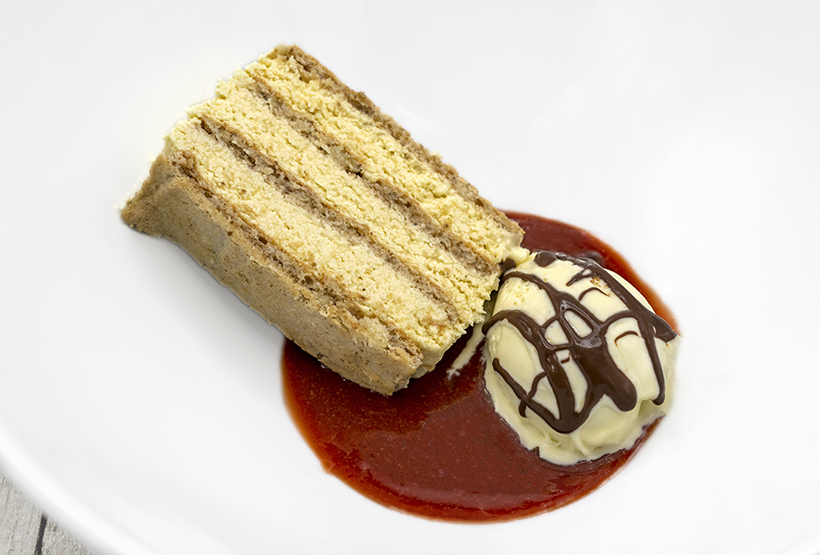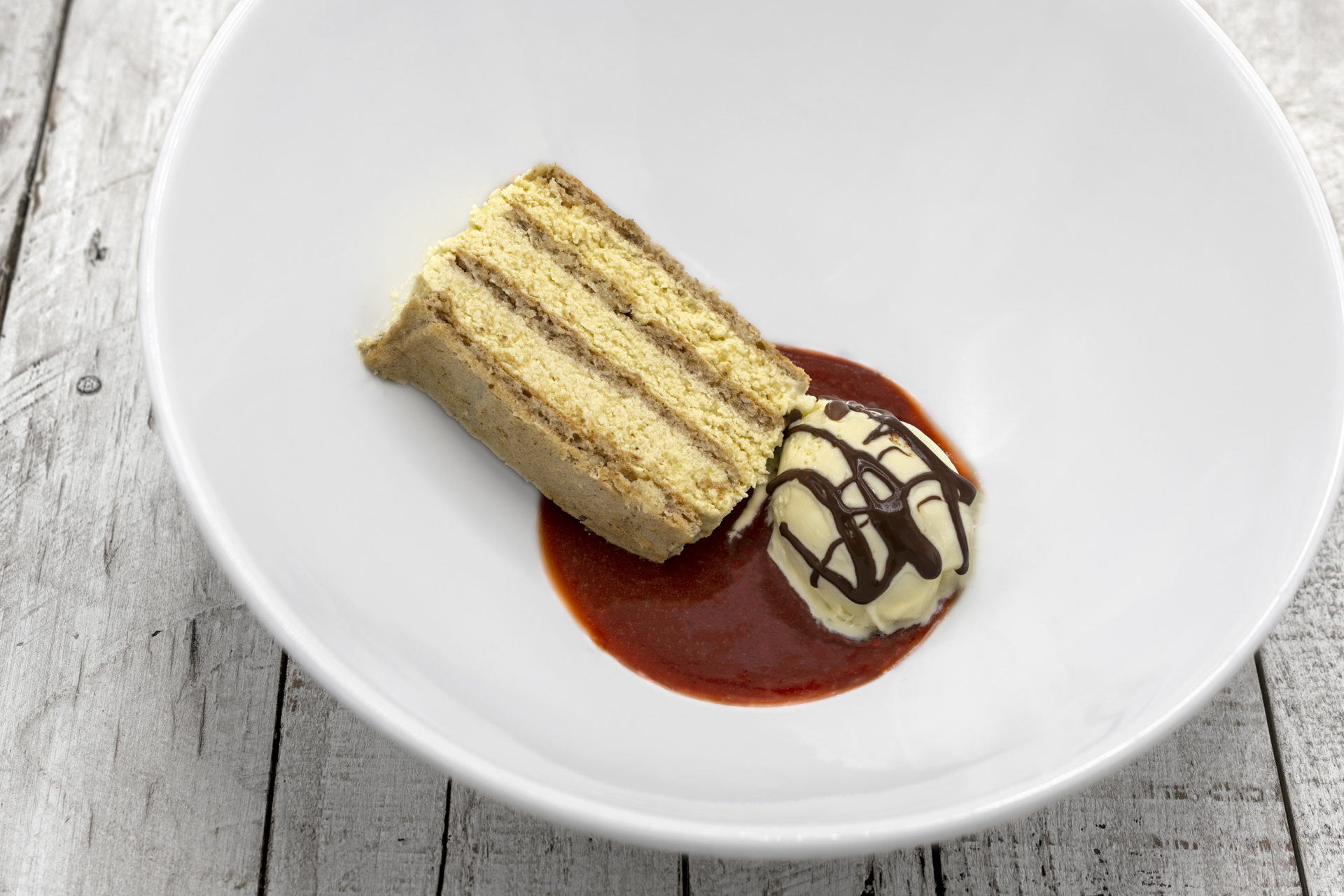The Esterházy torta is one of Hungary’s most famous desserts, alongside the Rigó Jancsi, the Somlói galuska, the Zserbó, and the Dobos. With its buttercream and macaron-like nut cake, it’s a very classic layered confection. Yet its origins are rather unclear…
Budapest, first half of the 19th century. A Hungarian noble family with roots in the Middle Ages, the Esterházy dynasty distinguishes itself by its consistent loyalty to the Habsburg rulers, its extensive landholdings, and its wealth. Unlike most of his ancestors, who served as military officers, Prince Paul III Anton Esterházy de Galántha (1786–1866) pursues a career in diplomacy. After occupying posts in Paris, London, and Dresden, he returns to Hungary in 1842. Known for his fabulous extravagance, he manages to spend beyond even his considerable means and supposedly ends his life in comparative poverty. And just like that, the story goes, some unknown confectioner in Budapest, at an unknown date and for some unknown reason, decides to name a cake after the man, and it quickly goes viral throughout the entire Austro-Hungarian nobility…
The Esterházy torta consists of flavored buttercream sandwiched between layers of a cake made with almond and meringue, then iced with a white fondant glaze and decorated with a characteristic chocolate striped pattern. But since its creator never published the recipe, variations abound without anyone being able to claim that they hold the true original version. First there’s the cake. In Hungary, the original almonds have been widely replaced by walnuts, although as recently as 1964, the famous chef János Rákóczi, in his book Konyhaművészet [Culinary Art], still listed “almonds or hazelnuts” as the proper ingredients. Debates also rage over whether there should be four layers or five. Then there’s the buttercream. Is it really a butter cream? Do you mix it with pastry cream? Do you use egg whites too? What is it supposed to be flavored with: rum, amaretto, cognac, vanilla, coffee? And does the flavoring really go into the buttercream, or is it used to soak the cake?

If you remember my review of Textúra in Budapest, the chef there has revisited the Esterházy torta: coming down on the four-layer side of the fence, he serves a cake slice laid down on the plate, topped with whipped cream and cocoa powder, accompanied with walnut ice cream; the obligatory white fondant with its dark chocolate pattern is relegated to a little square, a mere garnish.
From Textúra’s creation, I’m keeping a couple of ideas: an Esterházy torta that’s not a traditional round torta but more like a schnitte (or szelet in Hungarian), i.e., a rectangular slice; and the notion that the iconic fondant-chocolate pattern should be present but really isn’t all that exciting – it’s just sugar with a pattern drawn on it! Instead of the walnut ice cream, I’ve tried to come up with interesting pairings: white chocolate and sour cherry. Wait, what? White chocolate, that junk that’s not even real chocolate? Has he lost his mind?! I know, I know, I’m more of a 70+% dark chocolate kind of person myself. And yet, I tried both white and dark chocolate ice creams, and I must admit white chocolate works better here. Not only that, but in ice cream, the highest-quality white chocolate, the kind with 35% cocoa butter, doesn’t taste as good as the (still high-quality) 28% kind, such as Callebaut’s. It kind of makes sense, since white chocolate’s flavor mostly comes from the powdered milk it contains, magnified by a generous amount of sugar. A drizzle of dark chocolate sauce on top of the ice cream (recipe adapted from Ice Creams, Sorbets & Gelati) both reinforces the actual chocolate flavor and ticks the box regarding the signature decorative pattern.
As for the cake, I’m mixing both almonds and walnuts into the batter. The buttercream, flavored with cognac, vanilla, and almond extract all at once, is spread in thick layers that are kept light and airy by mixing the butter with a chiboust cream (a pastry cream mixed with a meringue). There are surprisingly few Esterházy torta recipes available in English, and those tend to be either unimpressive or bizarre. I would argue that mine is not only delicious, but strikes the perfect balance between tradition and innovation – and I’m totally objective.
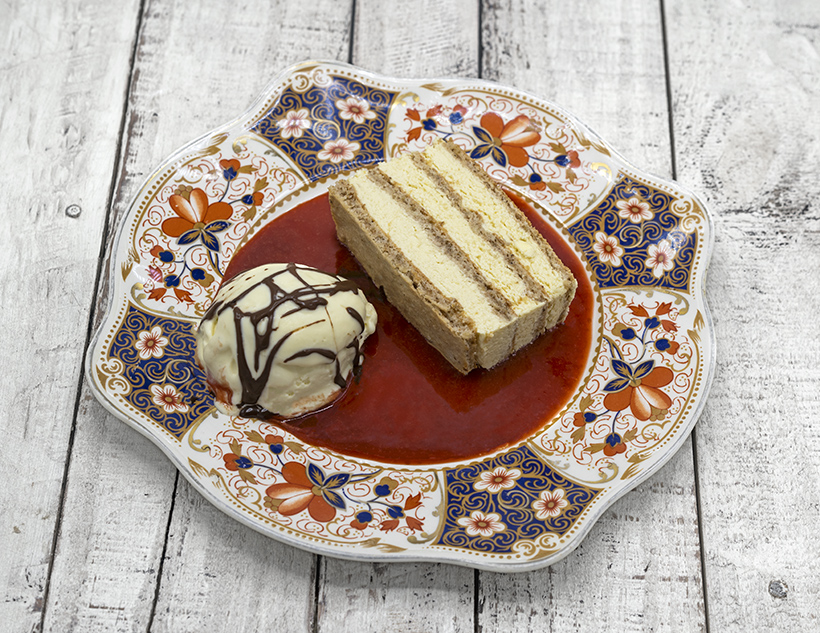
Esterházy Torte
Yields 6 servings
Total preparation: 11 hours
Active preparation: 1 hour 45 minutes
White chocolate ice cream
90 g white chocolate (with 28% cocoa butter), chopped
35 g (about 2) egg yolks
80 g sugar
400 g heavy cream
135 g milk
- Melt the white chocolate in a double boiler over medium heat, stirring regularly, then reserve.
- In the bowl of an electric mixer fitted with the paddle attachment, beat the egg yolks and sugar to a pale ribbon.
- In a saucepan over medium-high heat, bring the cream and milk to 95 C / 200 F. Pour half into the egg mixture while mixing on low speed. Pour the rest into the melted chocolate and mix with a spatula.
- Pour both mixtures together into the saucepan, and bring to 85 C / 185 F over low heat, stirring constantly with a spatula. Pass this custard through a chinois into a bowl over ice water, and let cool. Cover with plastic wrap and refrigerate for at least 2 hours.
- Churn the custard in an ice cream maker, following the manufacturer’s instructions. Transfer to the freezer for at least 8 hours. The ice cream can be made a day in advance.
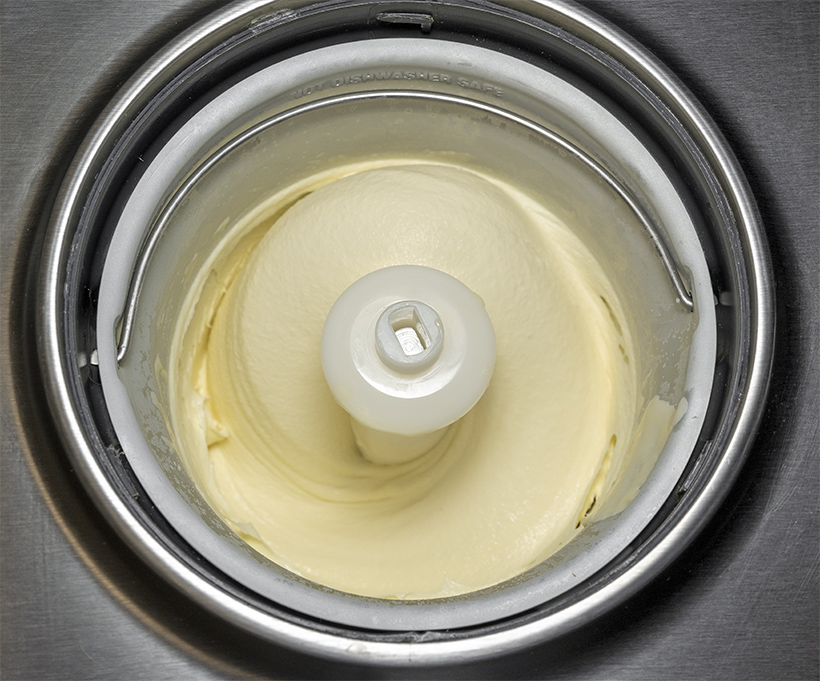
Sour cherry coulis
450 g pitted sour cherries
90 g water
95 g sugar
6 g lemon juice
- Place the pitted cherries into a small saucepan with the water, sugar, and lemon juice. Bring to a boil over medium heat, then simmer until the mixture has reduced to 300 g, stirring regularly.
- Transfer to a blender and purée on high speed for one minute, scraping down the sides if needed. Pass through a chinois and refrigerate for at least 2 hours. The coulis can be made up to 3 days in advance.
Nut cake layers
80 g walnut halves
75 g almond flour
30 g confectioners sugar
175 g (about 5) egg whites
100 g (granulated) sugar
- Grind the walnuts very finely in a food processor or a blender, using short pulses on high speed. Measure 75 g of this walnut flour, and combine with the almond flour and confectioners sugar in a container. (You can buy ready-made walnut flour instead, but unlike almond flour, it tends to be rare and expensive.)
- In the bowl of an electric mixer fitted with the whisk attachment, beat the egg whites to soft peaks on high speed. Gradually add the granulated sugar while still beating, then beat until stiff peaks form, about 1 minute. Gently fold in the nut four mixture using a spatula.
- On a baking sheet lined with parchment paper, spread the nut batter evenly into a 39 cm x 24 cm rectangle using an offset spatula. Bake in a 175 C / 350 F oven until golden brown and slightly crispy around the edges, 16-18 minutes.
- Place a cutting board or baking sheet over the cake, and invert together to flip. Peel away the parchment and let cool. Using a serrated knife, trim the uneven edges (I’ve included 1.5 cm margins in the dimensions of the whole cake), and cut the cake into four 9 cm x 21 cm rectangles.

Buttercream
35 g (about 2 1/2) egg yolks
160 g granulated sugar
15 g AP flour
170 g milk
4 g almond extract
5 g pure vanilla extract
25 g cognac
3 g gelatin
100 g (about 3) egg whites
45 g water
225 g unsalted butter, softened, cut into small pieces
- In a bowl, whisk the egg yolks with about 1/6 of the sugar to a pale ribbon, then mix in the flour.
- In a saucepan, bring the milk to a boil with about 1/2 of the remaining sugar. Slowly pour the milk over the egg mixture while mixing, to temper it, then return to the saucepan. Heat over medium heat, stirring constantly with a spatula, to a temperature of 85 C / 185 F. Remove from the heat and transfer this pastry cream to a large bowl.
- Warm the almond extract, vanilla extract, and cognac together in a small saucepan over low heat, and dissolve the gelatin in it. Let rest for 1 minute, then whisk into the pastry cream.
- In the bowl of an electric mixer fitted with the whisk attachment, beat the egg whites to soft peaks over high speed.
- In a saucepan, bring the water and remaining sugar to 110 C / 230 F, stirring regularly.
- With the mixer on lowest speed, add the sugar syrup into the bowl containing the egg whites by pouring a thin stream well away from the beaters. Beat for 10 minutes to cool. Gently fold this meringue into the pastry cream – you’ve just made chiboust cream. Cool the mixture for 5-10 minutes, either by refrigerating it or by placing the bowl in a larger bowl of ice water.
- In the bowl of an electric mixer fitted with the paddle attachment, beat the butter on high speed until smooth, about 1 minute. One tablespoon at a time, beat in the cooled chiboust cream on low speed. Finish assembling the cake immediately.
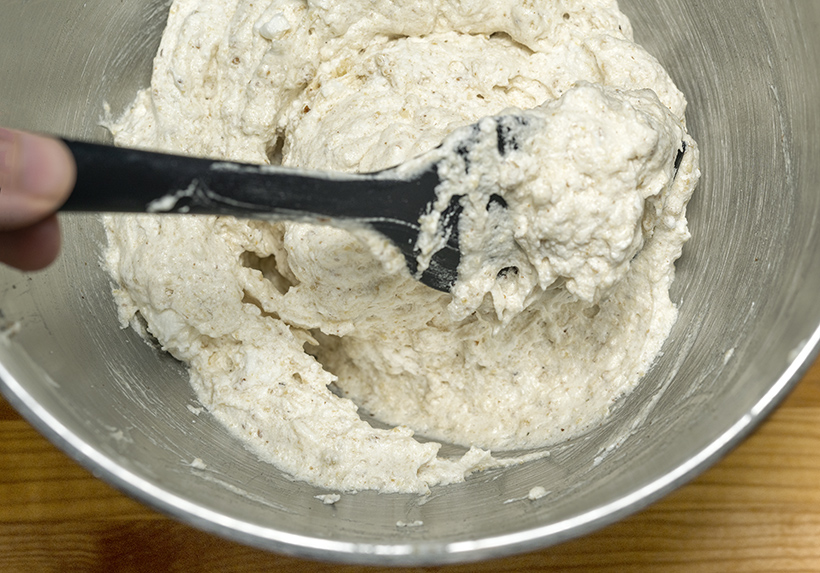
Esterházy torta
nut cake layers
buttercream
- Create a cardboard mold covered with tin foil, to the dimensions of the cake: LxWxH = 21 cm x 9 cm x ~7 cm (You might be able to buy an adjustable cake mold instead).
- Place one nut cake layer on the mold and spread with 1/3 of the buttercream (about 200 g) using an offset spatula. Repeat this twice, then cover with the last nut cake layer. If needed, tie the mold to help keep its shape. Refrigerate, uncovered, until the buttercream is firm and chilled, about 1 hour.
Assembly
white chocolate ice cream
40 g 70% dark chocolate, chopped
50 g heavy cream
Esterházy torta
sour cherry coulis
- Place the ice cream in the refrigerator for about 15 minutes, to soften.
- Place the dark chocolate and heavy cream in a small container and microwave for about 30 seconds, until the chocolate is melted. Stir with a spatula, then transfer to a small squeeze bottle.
- Use a sharp knife to cut off the ends of the torta, then cut 6 even slices, each about 3 cm thick.
- Onto each plate, pour enough sour cherry coulis to cover the bottom. Lay down one slice of the torta, off-center, and place a scoop of white chocolate ice cream next to it. Drizzle the ice cream with chocolate sauce to create your version of the Esterházy torta pattern (better examples here; my pictures feature the “yeah, whatever” pattern).
